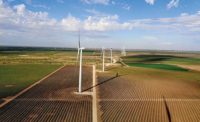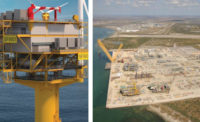In 2018, EPC contractor TGE Top Down delivered a $112-million, 10-story, 621,000-sq-ft office building in Bangalore, India, using a patented top-down building system. That was the first use of top-down construction since the 1970s. Now, TGE is in the design stage of its first U.S. project, Evolve, a 398,952-sq-ft, two-tower multifamily residential development in the Arapahoe Square District of Denver.
Retired founder and former chairman of Thornton Tomasetti Charles H. Thornton founded TGE Top Down with Jeff Grillo, an owner’s executive, and Dan Esparza, a contractor and veteran industry entrepreneur. The team has been working with developers to push for its use since it was successfully deployed in Bangalore.
Thornton witnessed delivery of one of the first buildings to use the method in 1973 and spent several years working with its inventor, the late David Termohlen, a 1971 ENR Newsmaker, to develop a global market. Thornton began refocusing those efforts into what became TGE Top Down in 2012.
“We came in about 25% less expensive than a high-rise, cast-in-place, flat-plate concrete project,” Thornton says of the two-tower project in Denver.
IMEG Corp. is on board as the structural engineer, Oz Architects and Sanzpont Spain are the design firms. TGE Top Down is the design-build contractor.
“We’ve got our vertical supply chain involved with the project,” Esparza says. “The job’s been three years in the making, but right now we’re in the Site Development Plan (SDP) amendment phase together with an early design development concurrent path.We hope to be breaking ground in Q2/Q3 of 2023, depending on permit issuance.”
The project has an expected construction cost of $122 million and developers eVolve Development Holdings LLC/Ubuntu Partners have purchased the land and confirmed delivery with the top-down construction method.
Esparza and Thornton say Evolve will be core-supported in both towers with cantilevered floors. Delivery of everything from curtainwall to MEP systems will be done using TGE Top Down’s manufacturing-process-enabled supply chain.
Esparza is a former construction executive for various Alaska Native Corporations construction firms.
He said top-down is a method the industry needs to embrace to achieve safety, sustainability, and labor goals.
“Our structure is the only structure that’s going to significantly reduce embodied carbon,” Esparza says. “When you knock off 40% of concrete and 25% of steel and the other benefits that come from that, you’re going have an embodied carbon profile reduction in core and shell or superstructure by a factor of 48% to 50%.”
Esparza says a traditional cast-in-place, flat-plate concrete building has about 250-300 psf of concrete, while a similar building delivered with TGE Top Down’s methods runs, on average,100 to 120 psf and even less in some situations.
He also says the designs TGE Top Down has been involved with for California projects are easier to seismically isolate because delivering a structure top-down simplifies and limits the number of foundation points. Three cores are easier to base isolate than 38 columns, for example.
In regard to safety, there was one recorded incident in 5 million person-hours on the two buildings TGE Top Down delivered in India.
Better overall building delivery to create more efficient buildings is TGE’s goal.
“If you can cut the number in half relative to material used, that’s slicing the labor number use, too,” Esparza said.
With less material, there is labor and less materials cost, he said.
“There’s a significant delta in overall price and your efficiency goes up, your productivity goes up,” Esparza explained. “Less design detailing, less clash detection and all of the other benefits and efficiencies come with that. The top-down system just drives efficiency.





Post a comment to this article
Report Abusive Comment